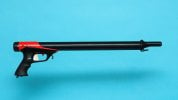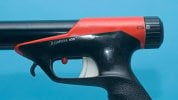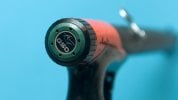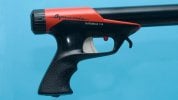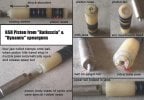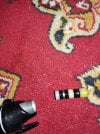GSD produced some stylish and innovative pneumatic spearguns in the seventies and eighties, but what happened to the company? Their last effort was the green bodied "Punto" that had a detachable air reservoir so that you could swap the rear handle around on 3 separate gun bodies of different lengths while each unit was still pressurized. The guns were sold with a very large carry case moulded in black plastic that held the grip handle, the three barrels, their respective spears and the various accessories. Just imagine taking that lot through airport security on an overseas dive vacation these days, assuming that you ever got out of the place!
The "Punto", which I have previously mentioned on another thread, is also unusual as the sear uses metal balls to lock the piston when the gun is cocked, I think that there are 3 of them, although I have never actually checked. Ball type sear systems are not common, one problem is that the balls can escape and roll around inside the gun if something does not function in exactly the correct sequence, necessitating a dismantling job. At least with the "Punto" you had two other barrels to keep you going if one was out of action. That said, I have never heard of anyone having this problem with a "Punto" mainly because few divers seemed to own them. Earlier GSD models used a trigger valve system, pulling the trigger opened a plug type valve that blocked the inner barrel at the rear end. This plug functioned as a non-return valve during muzzle loading of the spear, but when cranked open it allowed the pent up air to drive the piston and spear along the inner barrel. All GSD models had a collet type set of jaws on the front of the nylon piston which held a small ball mounted on the spear tail, the rubber shock absorber being mounted on the piston body rather than in the muzzle itself. It was said that the GSD spearguns could be fired in the air due to the braking action of the pistons as the jaws expanded at the end of the inner barrel travel, but as speargun accidents are usually big ones it is not something to be recommended!
The "Punto", which I have previously mentioned on another thread, is also unusual as the sear uses metal balls to lock the piston when the gun is cocked, I think that there are 3 of them, although I have never actually checked. Ball type sear systems are not common, one problem is that the balls can escape and roll around inside the gun if something does not function in exactly the correct sequence, necessitating a dismantling job. At least with the "Punto" you had two other barrels to keep you going if one was out of action. That said, I have never heard of anyone having this problem with a "Punto" mainly because few divers seemed to own them. Earlier GSD models used a trigger valve system, pulling the trigger opened a plug type valve that blocked the inner barrel at the rear end. This plug functioned as a non-return valve during muzzle loading of the spear, but when cranked open it allowed the pent up air to drive the piston and spear along the inner barrel. All GSD models had a collet type set of jaws on the front of the nylon piston which held a small ball mounted on the spear tail, the rubber shock absorber being mounted on the piston body rather than in the muzzle itself. It was said that the GSD spearguns could be fired in the air due to the braking action of the pistons as the jaws expanded at the end of the inner barrel travel, but as speargun accidents are usually big ones it is not something to be recommended!



